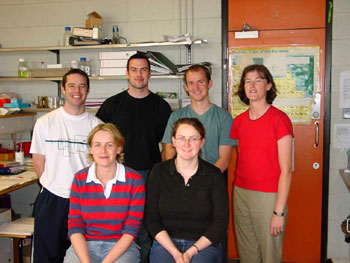| 2003 |

|
YEAR BOOK |
Institute of Technology Tallaght
|
IT Tallaght Electrochemical Technology Research Centre (ETRC)
- employing modern electrochemistry in material science |

The ETRC at IT Tallaght has successfully synthesized a range of novel redox active materials based upon transition metal salts of isopolyanions. These materials exhibit well-defined redox processes associated with both the tungsten-oxo framework of the isopolyanion, and the metal-based oxidation process. This research aims to develop novel redox active solid state materials that exhibit rapid electron and ionic transport and will involve the use of modern voltammetric methods coupled with the use of microelectrodes, together with state-of-the-art surface techniques with both high and low spatial resolutions.
In addition, the team in the ETRC is actively involved in several multidisciplinary research projects with national and international research teams. One of these involves the development of a sensor for lactate, which is a main topic in intensive care medicine, as the level of lactate is related to the amount of oxygen in the tissues. Enzyme electrodes (biosensors) are useful analytical tools, which allow measurement in complex biological fluids. They are based on the entrapment of the appropriate enzyme (e.g. lactate oxidase) on an electrode (e.g. carbon) surface. This project aims to develop novel materials, based on metal complexes, which will enable both stable entrapment of the enzyme and rapid mediation of the signal generated.
Other collaborative research projects, along with relevant partners include:
|
� Design of Novel Redox Active Conducting Polymers - Dr John Cassidy, DIT, Dublin
� Novel Multicomponent p-Conjugated Polymers - Dr Stephane Guillerez, CEA, Grenoble, France � Electrochemical Investigations into Endocrine Disrupting Compounds - Prof. Joseph Wang, New Mexico State University, USA. |
Contact: Dr Tim McCormac;
Tel: 01-4042814; Fax: 01-4042700; E-mail: [email protected] ;
Dr Eithne Dempsey;
Tel: 01-4042862; Fax: 01-4042700; E-mail: [email protected] ;
Electrochemical Technology Research Centre, Institute of Technology Tallaght, Dublin 24.